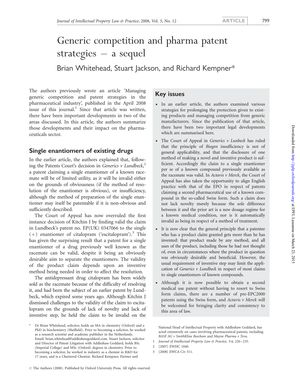Generic Competition And Pharmaceutical Patent Strategies: A Sequel
October 2008
in “
Journal of Intellectual Property Law & Practice
”
pharmaceutical patents generic competition patent strategies citalopram escitalopram enantiomer racemate Swiss form claim European Patent Office EPO second pharmaceutical use dosage regime method of treatment pharma patents generic drugs patent tactics Celexa Lexapro drug enantiomer drug racemate Swiss claim second use dosage plan treatment method

TLDR The article concludes that recent legal rulings have strengthened the protection of pharmaceutical patents against generic competition.
In the 2008 article, the authors discuss two significant legal developments in the pharmaceutical industry regarding patent strategies against generic competition. The first development involves the Court of Appeal's decision in Generics v Lundbeck, which overruled a previous decision and found a patent for the single (+) enantiomer of citalopram (escitalopram) to be valid. This ruling was surprising because it allowed for a patent on a single enantiomer of a drug previously known as a racemate, despite the separation of enantiomers being an obvious goal. The validity of such a patent now depends on whether an inventive method is needed for the resolution of the enantiomer. The second development is the Court of Appeal's decision in Actavis v Merck, which aligned English practice with the European Patent Office (EPO) regarding patents claiming a second pharmaceutical use of a known compound. The court ruled that a Swiss form claim does not lack novelty simply because it involves a new dosage regime for a known medical condition, nor is it automatically invalid as a method of treatment. This decision brings clarity and consistency to the law and is welcomed for pre-European Patent Convention 2000 patents that use the Swiss form. These developments have implications for the protection of pharmaceutical patents and the management of generic competition.



